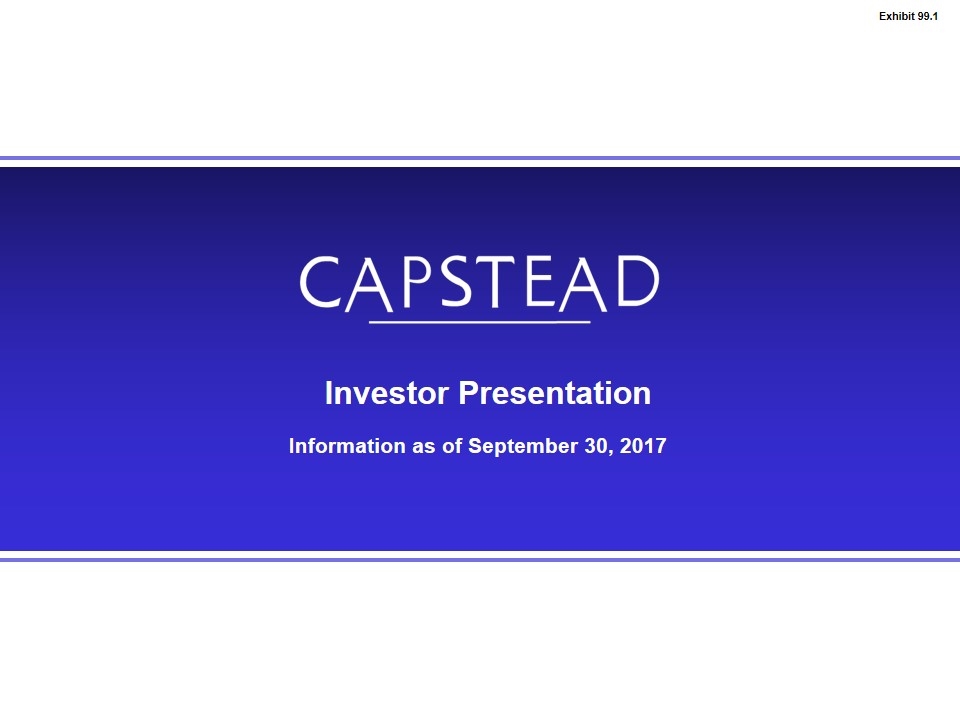
Information as of September 30, 2017 Investor Presentation Exhibit 99.1
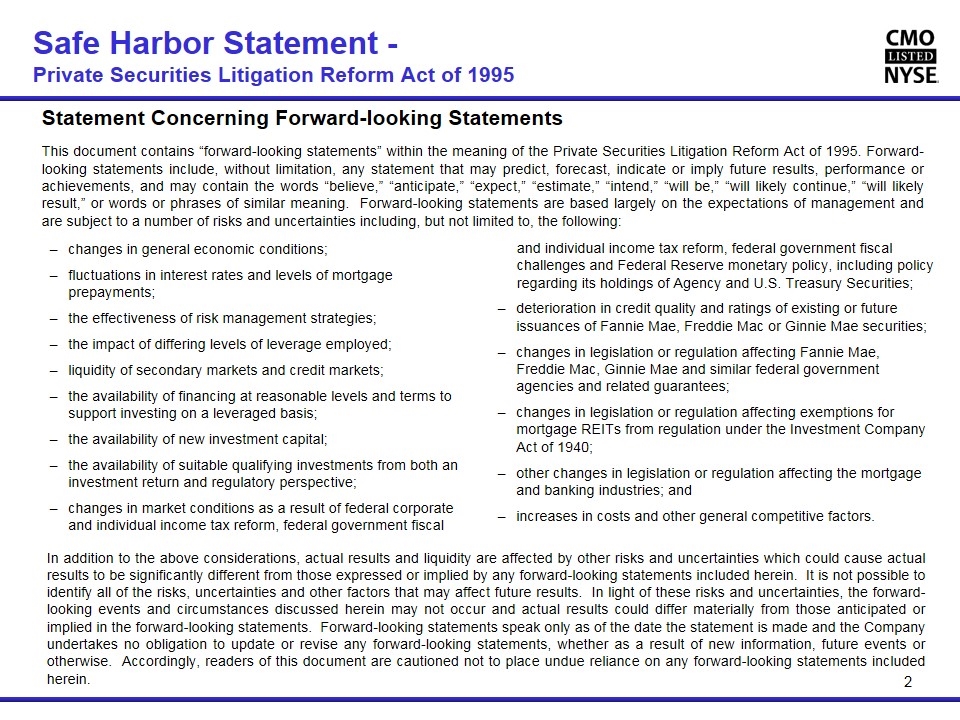
and individual income tax reform, federal government fiscal challenges and Federal Reserve monetary policy, including policy regarding its holdings of Agency and U.S. Treasury Securities; deterioration in credit quality and ratings of existing or future issuances of Fannie Mae, Freddie Mac or Ginnie Mae securities; changes in legislation or regulation affecting Fannie Mae, Freddie Mac, Ginnie Mae and similar federal government agencies and related guarantees; changes in legislation or regulation affecting exemptions for mortgage REITs from regulation under the Investment Company Act of 1940; other changes in legislation or regulation affecting the mortgage and banking industries; and increases in costs and other general competitive factors. Safe Harbor Statement - Private Securities Litigation Reform Act of 1995 Statement Concerning Forward-looking Statements This document contains “forward-looking statements” within the meaning of the Private Securities Litigation Reform Act of 1995. Forward-looking statements include, without limitation, any statement that may predict, forecast, indicate or imply future results, performance or achievements, and may contain the words “believe,” “anticipate,” “expect,” “estimate,” “intend,” “will be,” “will likely continue,” “will likely result,” or words or phrases of similar meaning. Forward-looking statements are based largely on the expectations of management and are subject to a number of risks and uncertainties including, but not limited to, the following: In addition to the above considerations, actual results and liquidity are affected by other risks and uncertainties which could cause actual results to be significantly different from those expressed or implied by any forward-looking statements included herein. It is not possible to identify all of the risks, uncertainties and other factors that may affect future results. In light of these risks and uncertainties, the forward-looking events and circumstances discussed herein may not occur and actual results could differ materially from those anticipated or implied in the forward-looking statements. Forward-looking statements speak only as of the date the statement is made and the Company undertakes no obligation to update or revise any forward-looking statements, whether as a result of new information, future events or otherwise. Accordingly, readers of this document are cautioned not to place undue reliance on any forward-looking statements included herein. changes in general economic conditions; fluctuations in interest rates and levels of mortgage prepayments; the effectiveness of risk management strategies; the impact of differing levels of leverage employed; liquidity of secondary markets and credit markets; the availability of financing at reasonable levels and terms to support investing on a leveraged basis; the availability of new investment capital; the availability of suitable qualifying investments from both an investment return and regulatory perspective; changes in market conditions as a result of federal corporate and individual income tax reform, federal government fiscal 2
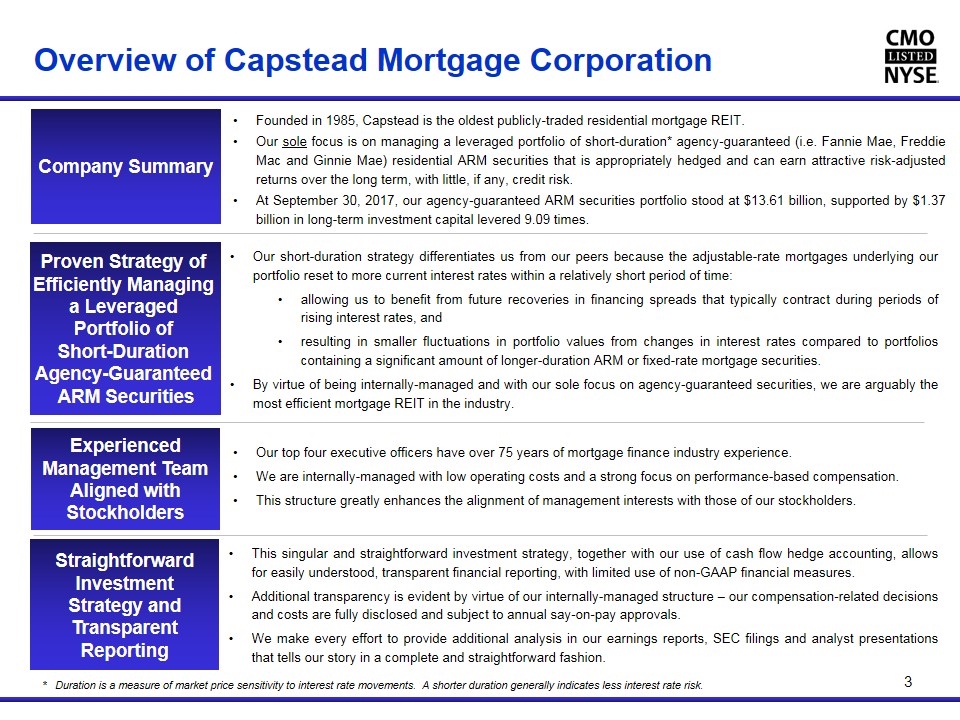
Company Summary Proven Strategy of Efficiently Managing a Leveraged Portfolio of Short-Duration Agency-Guaranteed ARM Securities Experienced Management Team Aligned with Stockholders Overview of Capstead Mortgage Corporation Founded in 1985, Capstead is the oldest publicly-traded residential mortgage REIT. Our sole focus is on managing a leveraged portfolio of short-duration* agency-guaranteed (i.e. Fannie Mae, Freddie Mac and Ginnie Mae) residential ARM securities that is appropriately hedged and can earn attractive risk-adjusted returns over the long term, with little, if any, credit risk. At September 30, 2017, our agency-guaranteed ARM securities portfolio stood at $13.61 billion, supported by $1.37 billion in long-term investment capital levered 9.09 times. Our short-duration strategy differentiates us from our peers because the adjustable-rate mortgages underlying our portfolio reset to more current interest rates within a relatively short period of time: allowing us to benefit from future recoveries in financing spreads that typically contract during periods of rising interest rates, and resulting in smaller fluctuations in portfolio values from changes in interest rates compared to portfolios containing a significant amount of longer-duration ARM or fixed-rate mortgage securities. By virtue of being internally-managed and with our sole focus on agency-guaranteed securities, we are arguably the most efficient mortgage REIT in the industry. Our top four executive officers have over 75 years of mortgage finance industry experience. We are internally-managed with low operating costs and a strong focus on performance-based compensation. This structure greatly enhances the alignment of management interests with those of our stockholders. 3 This singular and straightforward investment strategy, together with our use of cash flow hedge accounting, allows for easily understood, transparent financial reporting, with limited use of non-GAAP financial measures. Additional transparency is evident by virtue of our internally-managed structure – our compensation-related decisions and costs are fully disclosed and subject to annual say-on-pay approvals. We make every effort to provide additional analysis in our earnings reports, SEC filings and analyst presentations that tells our story in a complete and straightforward fashion. Straightforward Investment Strategy and Transparent Reporting * Duration is a measure of market price sensitivity to interest rate movements. A shorter duration generally indicates less interest rate risk.
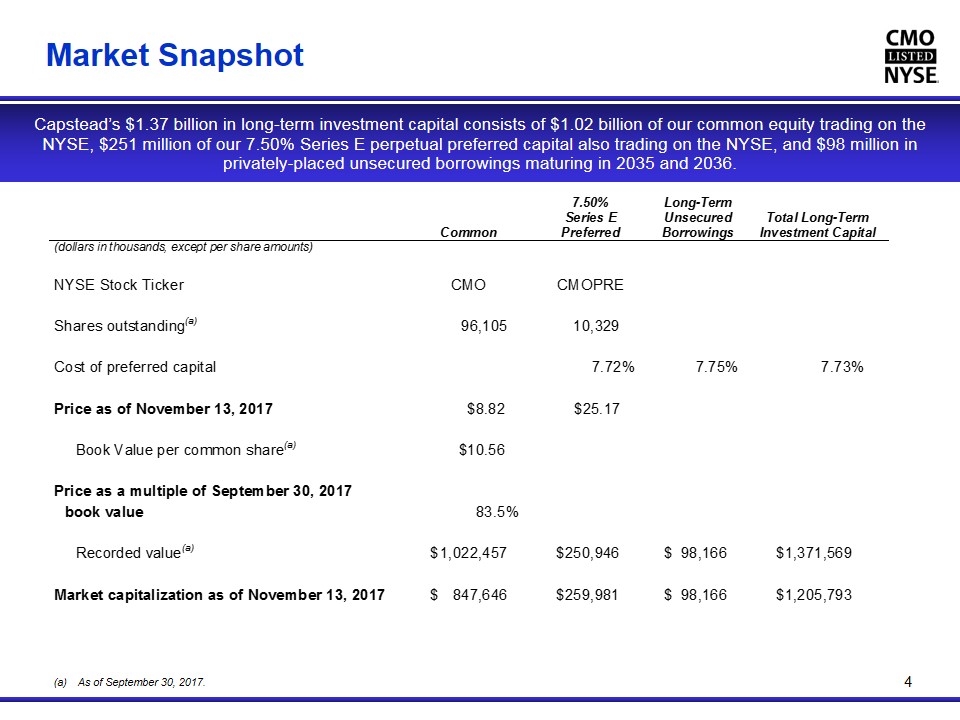
Market Snapshot 4 As of September 30, 2017. Capstead’s $1.37 billion in long-term investment capital consists of $1.02 billion of our common equity trading on the NYSE, $251 million of our 7.50% Series E perpetual preferred capital also trading on the NYSE, and $98 million in privately-placed unsecured borrowings maturing in 2035 and 2036.
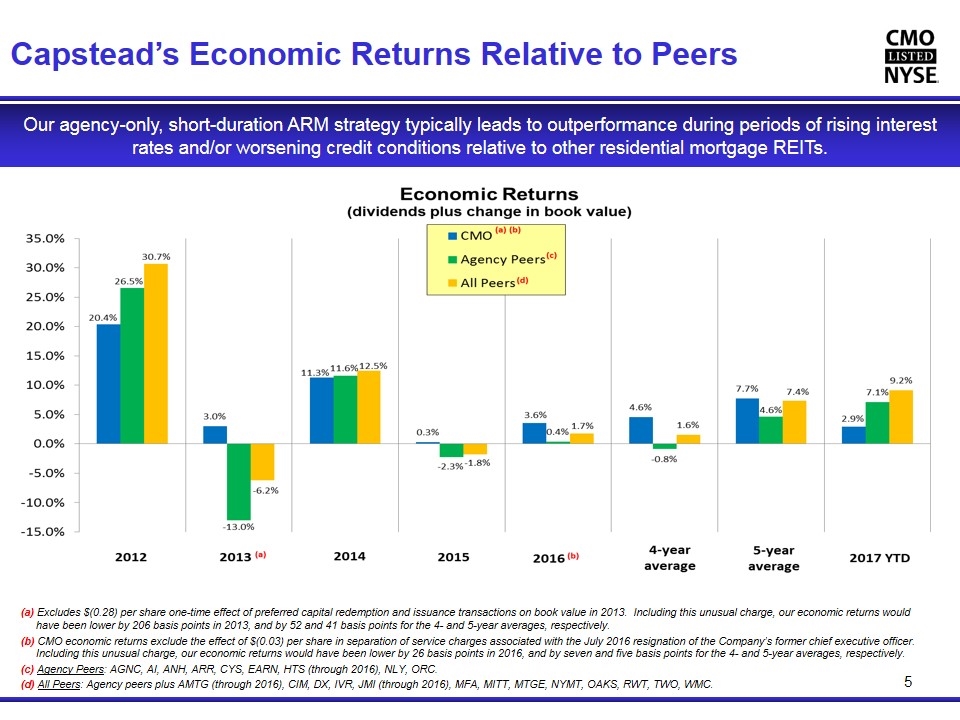
Capstead’s Economic Returns Relative to Peers Our agency-only, short-duration ARM strategy typically leads to outperformance during periods of rising interest rates and/or worsening credit conditions relative to other residential mortgage REITs. 5 (a) Excludes $(0.28) per share one-time effect of preferred capital redemption and issuance transactions on book value in 2013. Including this unusual charge, our economic returns would have been lower by 206 basis points in 2013, and by 52 and 41 basis points for the 4- and 5-year averages, respectively. (b) CMO economic returns exclude the effect of $(0.03) per share in separation of service charges associated with the July 2016 resignation of the Company’s former chief executive officer. Including this unusual charge, our economic returns would have been lower by 26 basis points in 2016, and by seven and five basis points for the 4- and 5-year averages, respectively. (c) Agency Peers: AGNC, AI, ANH, ARR, CYS, EARN, HTS (through 2016), NLY, ORC. (d) All Peers: Agency peers plus AMTG (through 2016), CIM, DX, IVR, JMI (through 2016), MFA, MITT, MTGE, NYMT, OAKS, RWT, TWO, WMC.
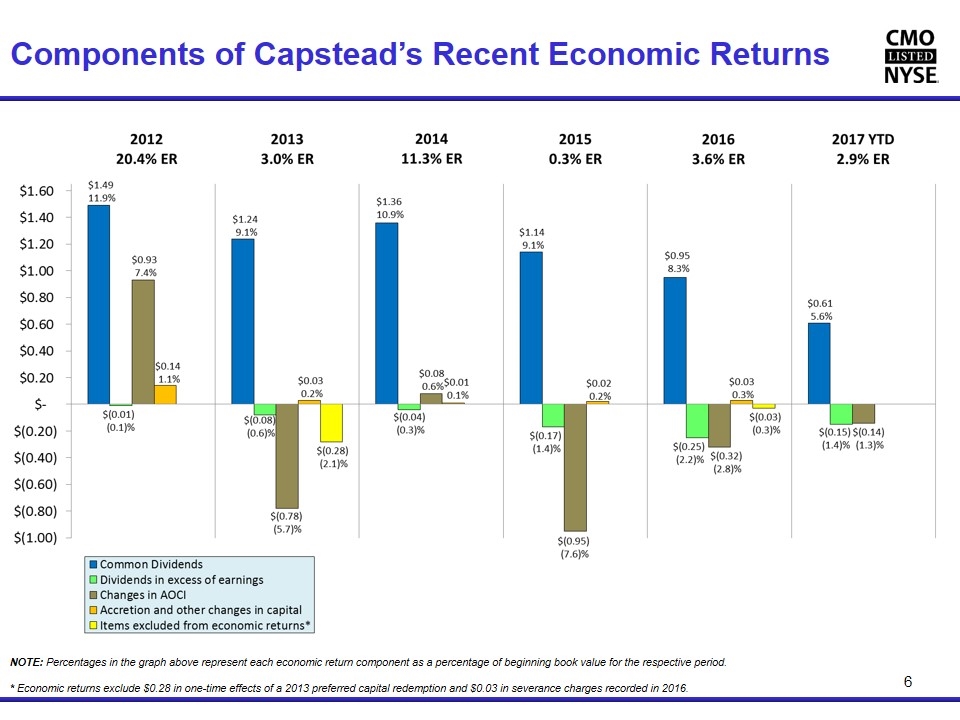
Components of Capstead’s Recent Economic Returns 6 NOTE: Percentages in the graph above represent each economic return component as a percentage of beginning book value for the respective period. * Economic returns exclude $0.28 in one-time effects of a 2013 preferred capital redemption and $0.03 in severance charges recorded in 2016.
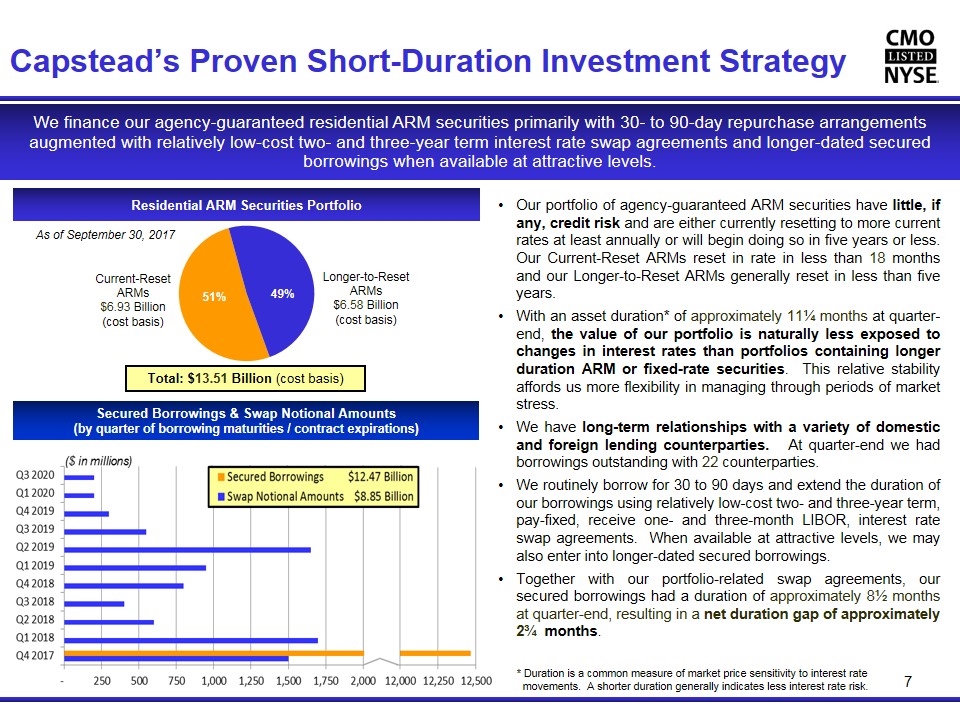
Capstead’s Proven Short-Duration Investment Strategy 7 As of September 30, 2017 We finance our agency-guaranteed residential ARM securities primarily with 30- to 90-day repurchase arrangements augmented with relatively low-cost two- and three-year term interest rate swap agreements and longer-dated secured borrowings when available at attractive levels. Residential ARM Securities Portfolio Secured Borrowings & Swap Notional Amounts (by quarter of borrowing maturities / contract expirations) Total: $13.51 Billion (cost basis) Our portfolio of agency-guaranteed ARM securities have little, if any, credit risk and are either currently resetting to more current rates at least annually or will begin doing so in five years or less. Our Current-Reset ARMs reset in rate in less than 18 months and our Longer-to-Reset ARMs generally reset in less than five years. With an asset duration* of approximately 11¼ months at quarter-end, the value of our portfolio is naturally less exposed to changes in interest rates than portfolios containing longer duration ARM or fixed-rate securities. This relative stability affords us more flexibility in managing through periods of market stress. We have long-term relationships with a variety of domestic and foreign lending counterparties. At quarter-end we had borrowings outstanding with 22 counterparties. We routinely borrow for 30 to 90 days and extend the duration of our borrowings using relatively low-cost two- and three-year term, pay-fixed, receive one- and three-month LIBOR, interest rate swap agreements. When available at attractive levels, we may also enter into longer-dated secured borrowings. Together with our portfolio-related swap agreements, our secured borrowings had a duration of approximately 8½ months at quarter-end, resulting in a net duration gap of approximately 2¾ months. Longer-to-Reset ARMs $6.58 Billion (cost basis) Current-Reset ARMs $6.93 Billion (cost basis) * Duration is a common measure of market price sensitivity to interest rate movements. A shorter duration generally indicates less interest rate risk.
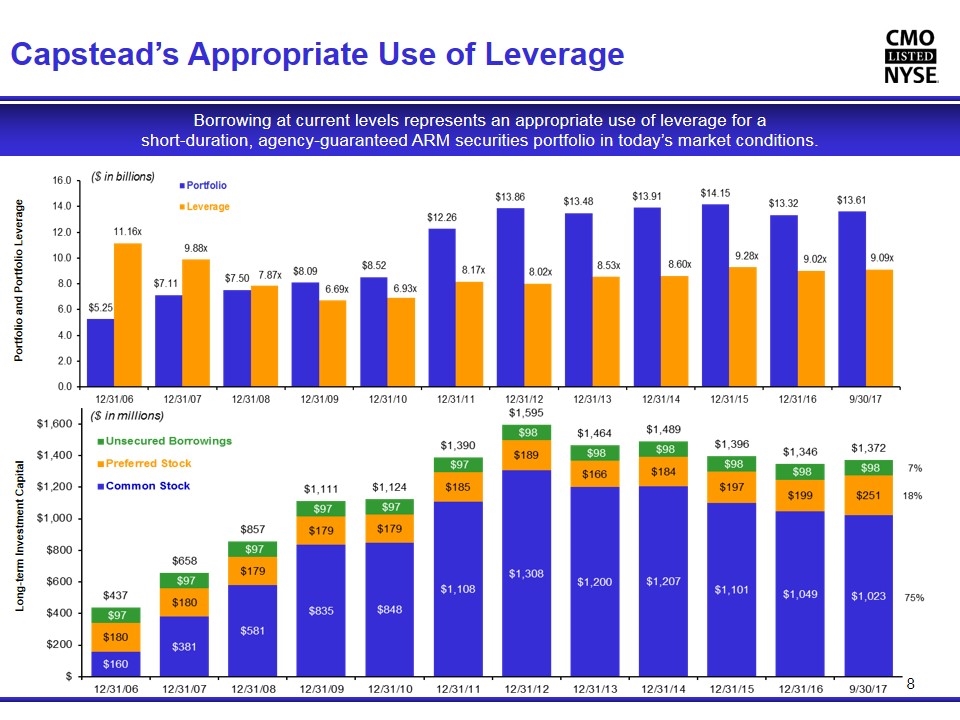
Capstead’s Appropriate Use of Leverage 8 Portfolio and Portfolio Leverage Borrowing at current levels represents an appropriate use of leverage for a short-duration, agency-guaranteed ARM securities portfolio in today’s market conditions. Long-term Investment Capital
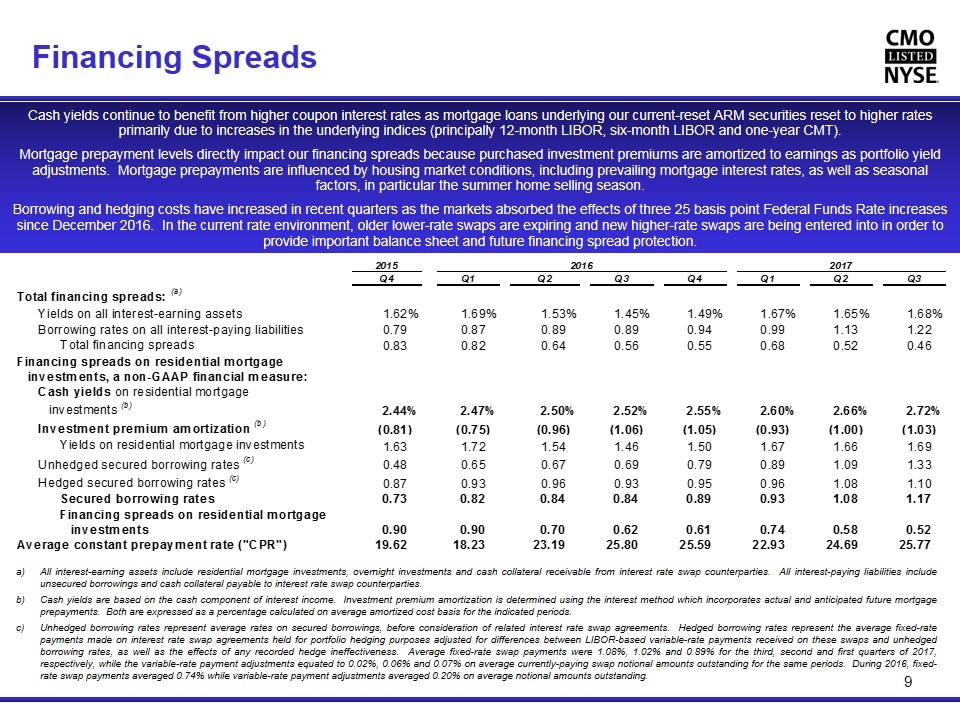
Financing Spreads 9 Cash yields continue to benefit from higher coupon interest rates as mortgage loans underlying our current-reset ARM securities reset to higher rates primarily due to increases in the underlying indices (principally 12-month LIBOR, six-month LIBOR and one-year CMT). Mortgage prepayment levels directly impact our financing spreads because purchased investment premiums are amortized to earnings as portfolio yield adjustments. Mortgage prepayments are influenced by housing market conditions, including prevailing mortgage interest rates, as well as seasonal factors, in particular the summer home selling season. Borrowing and hedging costs have increased in recent quarters as the markets absorbed the effects of three 25 basis point Federal Funds Rate increases since December 2016. In the current rate environment, older lower-rate swaps are expiring and new higher-rate swaps are being entered into in order to provide important balance sheet and future financing spread protection. All interest-earning assets include residential mortgage investments, overnight investments and cash collateral receivable from interest rate swap counterparties. All interest-paying liabilities include unsecured borrowings and cash collateral payable to interest rate swap counterparties. Cash yields are based on the cash component of interest income. Investment premium amortization is determined using the interest method which incorporates actual and anticipated future mortgage prepayments. Both are expressed as a percentage calculated on average amortized cost basis for the indicated periods. Unhedged borrowing rates represent average rates on secured borrowings, before consideration of related interest rate swap agreements. Hedged borrowing rates represent the average fixed-rate payments made on interest rate swap agreements held for portfolio hedging purposes adjusted for differences between LIBOR-based variable-rate payments received on these swaps and unhedged borrowing rates, as well as the effects of any recorded hedge ineffectiveness. Average fixed-rate swap payments were 1.08%, 1.02% and 0.89% for the third, second and first quarters of 2017, respectively, while the variable-rate payment adjustments equated to 0.02%, 0.06% and 0.07% on average currently-paying swap notional amounts outstanding for the same periods. During 2016, fixed-rate swap payments averaged 0.74% while variable-rate payment adjustments averaged 0.20% on average notional amounts outstanding. 2015 2016 2017 Q4 Q1 Q2 Q3 Q4 Q1 Q2 Q3 Total financing spreads: (a) Yields on all interest-earning assets 1.6199999999999999E-2 1.6899999999999998E-2 1.5299999999999999E-2 1.4500000000000001E-2 1.49E-2 1.6744443138806513E-2 1.6538044539174877E-2 1.6815378021486818E-2 Borrowing rates on all interest-paying liabilities 0.79 0.87 0.89 0.89 0.94 0.98905919200084558 1.1348020394569407 1.2196301189627354 Total financing spreads 0.83 0.82 0.64 0.56000000000000005 0.55000000000000004 0.67538512187980571 0.51900241446054696 0.46190768318594633 Financing spreads on residential mortgage investments, a non-GAAP financial measure: Cash yields on residential mortgage investments (b) 2.4400000000000002E-2 2.47E-2 2.5000000000000001E-2 2.52E-2 2.5499999999999998E-2 2.601829951035E-2 2.65932394112556E-2 2.7199999999999998E-2 Investment premium amortization (b) -0.81 -0.75 -0.96 -1.06 -1.05 -0.9276201189174802 -0.99722995542878301 -1.0344784968147631 Yields on residential mortgage investments 1.63 1.72 1.54 1.46 1.5 1.6742098321175169 1.6620939856967749 1.6893229147754669 Unhedged secured borrowing rates (c) 0.48 0.65 0.67 0.69 0.79 0.89120993516127578 1.0910109354249296 1.328561732233918 Hedged secured borrowing rates (c) 0.87 0.93 0.96 0.93 0.95 0.95657351995620687 1.0779900805029872 1.0983795041158759 Secured borrowing rates 0.73 0.82 0.84 0.84 0.89 0.93451370095067998 1.0829259612566788 1.1683002581666346 Financing spreads on residential mortgage investments 0.9 0.9 0.7 0.62 0.61 0.73969613116683708 0.57916802444009596 0.52102265660883218 Average constant prepayment rate ("CPR") 19.62 18.23 23.19 25.8 25.59 22.929172637324434 24.69 25.766077320258802
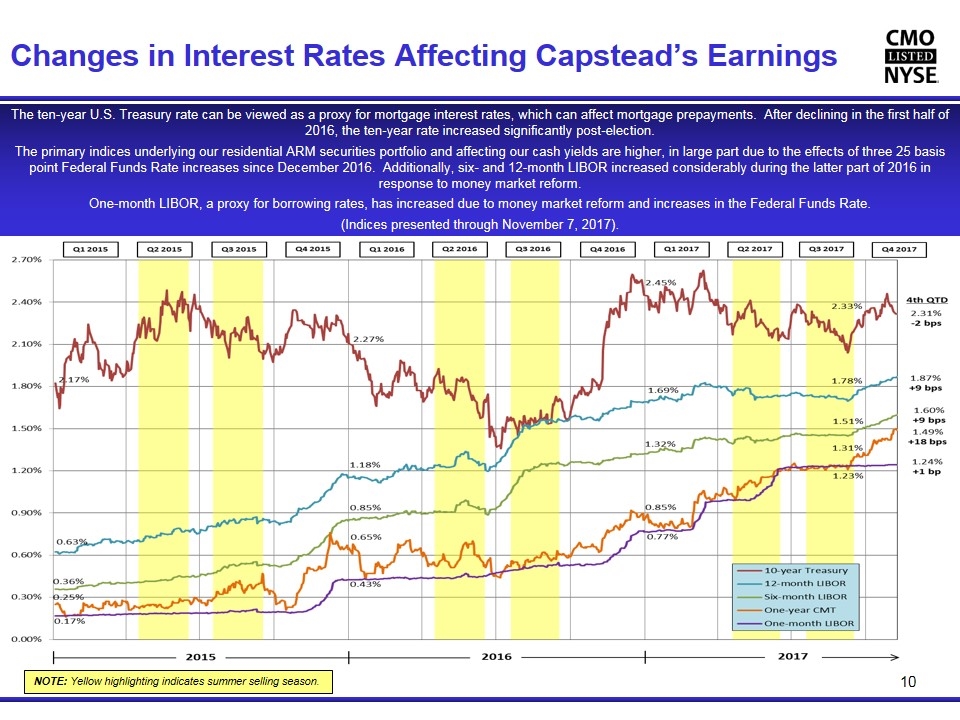
Changes in Interest Rates Affecting Capstead’s Earnings The ten-year U.S. Treasury rate can be viewed as a proxy for mortgage interest rates, which can affect mortgage prepayments. After declining in the first half of 2016, the ten-year rate increased significantly post-election. The primary indices underlying our residential ARM securities portfolio and affecting our cash yields are higher, in large part due to the effects of three 25 basis point Federal Funds Rate increases since December 2016. Additionally, six- and 12-month LIBOR increased considerably during the latter part of 2016 in response to money market reform. One-month LIBOR, a proxy for borrowing rates, has increased due to money market reform and increases in the Federal Funds Rate. (Indices presented through November 7, 2017). 10 NOTE: Yellow highlighting indicates summer selling season.
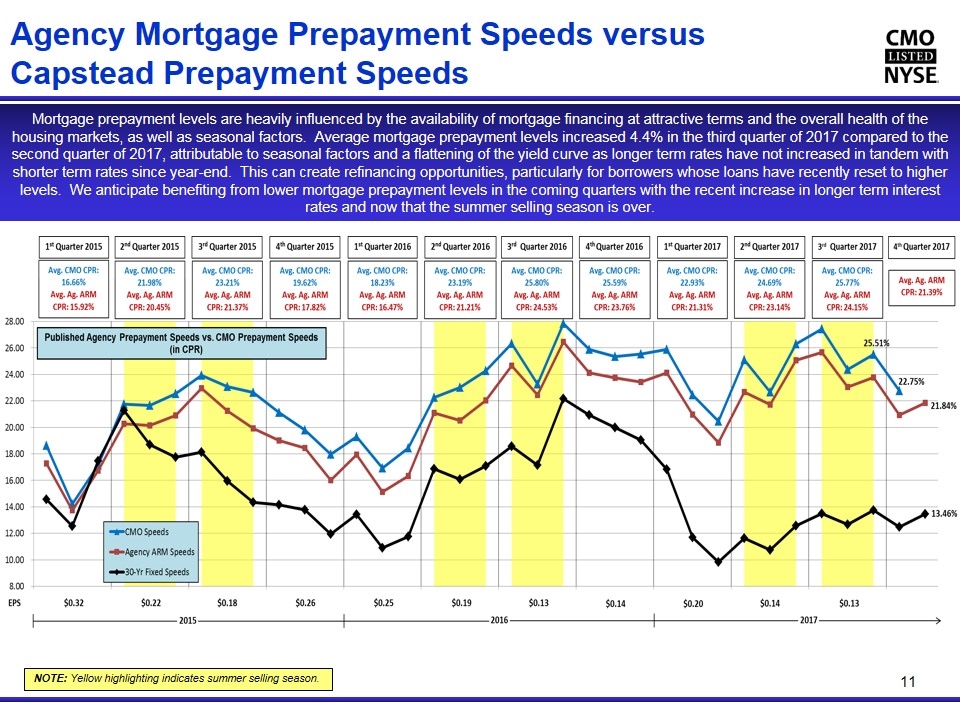
Agency Mortgage Prepayment Speeds versus Capstead Prepayment Speeds Mortgage prepayment levels are heavily influenced by the availability of mortgage financing at attractive terms and the overall health of the housing markets, as well as seasonal factors. Average mortgage prepayment levels increased 4.4% in the third quarter of 2017 compared to the second quarter of 2017, attributable to seasonal factors and a flattening of the yield curve as longer term rates have not increased in tandem with shorter term rates since year-end. This can create refinancing opportunities, particularly for borrowers whose loans have recently reset to higher levels. We anticipate benefiting from lower mortgage prepayment levels in the coming quarters with the recent increase in longer term interest rates and now that the summer selling season is over. 11 NOTE: Yellow highlighting indicates summer selling season.
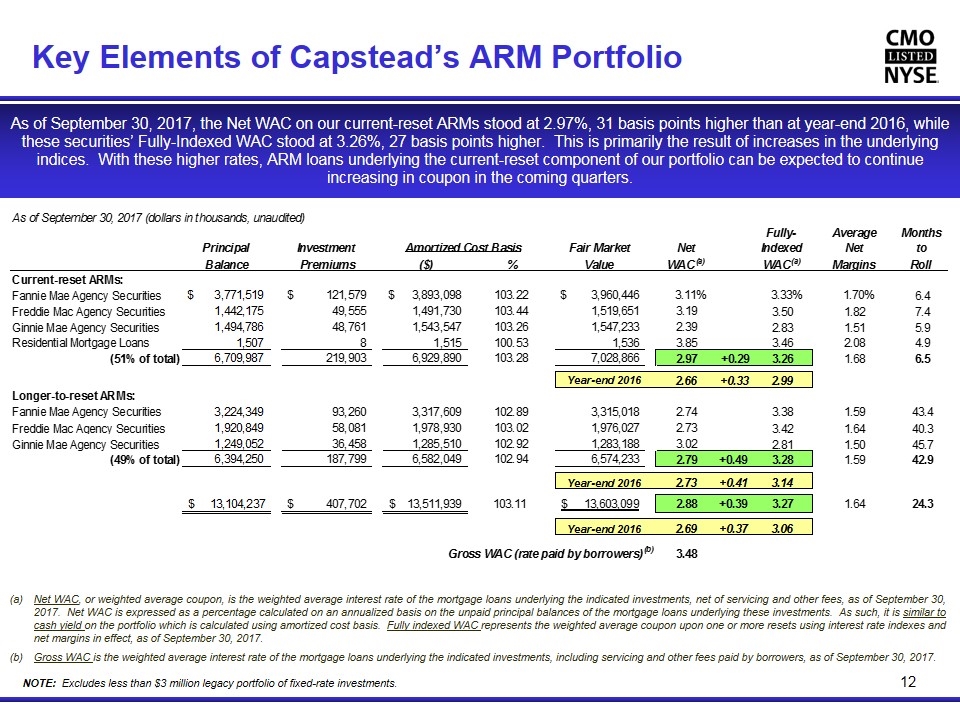
Key Elements of Capstead’s ARM Portfolio 12 NOTE: Excludes less than $3 million legacy portfolio of fixed-rate investments. As of September 30, 2017, the Net WAC on our current-reset ARMs stood at 2.97%, 31 basis points higher than at year-end 2016, while these securities’ Fully-Indexed WAC stood at 3.26%, 27 basis points higher. This is primarily the result of increases in the underlying indices. With these higher rates, ARM loans underlying the current-reset component of our portfolio can be expected to continue increasing in coupon in the coming quarters. Net WAC, or weighted average coupon, is the weighted average interest rate of the mortgage loans underlying the indicated investments, net of servicing and other fees, as of September 30, 2017. Net WAC is expressed as a percentage calculated on an annualized basis on the unpaid principal balances of the mortgage loans underlying these investments. As such, it is similar to cash yield on the portfolio which is calculated using amortized cost basis. Fully indexed WAC represents the weighted average coupon upon one or more resets using interest rate indexes and net margins in effect, as of September 30, 2017. Gross WAC is the weighted average interest rate of the mortgage loans underlying the indicated investments, including servicing and other fees paid by borrowers, as of September 30, 2017. As of September 30, 2017 (dollars in thousands, unaudited) Fully- Average Months Principal Investment Amortized Cost Basis Fair Market Net Indexed Net to Balance Premiums ($) % Value WAC(a) WAC(a) Margins Roll Current-reset ARMs: Fannie Mae Agency Securities $3,771,519 $,121,579 $3,893,098 103.22360831272492 $3,960,446 3.11% 3.33% 1.70% 6.4 Freddie Mac Agency Securities 1,442,175 49,555 1,491,730 103.43612945724341 1,519,651 3.19 3.5 1.82 7.4 Ginnie Mae Agency Securities 1,494,786 48,761 1,543,547 103.26207229663645 1,547,233 2.39 2.83 1.51 5.9 Residential Mortgage Loans 1,507 8 1,515 100.53085600530855 1,536 3.85 3.46 2.08 4.9000000000000004 (51% of total) 6,709,987 ,219,903 6,929,890 103.27724927037862 7,028,866 2.97 +0.29 3.26 1.68 6.5 Year-end 2016 2.66 +0.33 2.99 Longer-to-reset ARMs: Fannie Mae Agency Securities 3,224,349 93,260 3,317,609 102.89236680024403 3,315,018 2.74 3.38 1.59 43.4 Freddie Mac Agency Securities 1,920,849 58,081 1,978,930 103.02371503434158 1,976,027 2.73 3.42 1.64 40.299999999999997 Ginnie Mae Agency Securities 1,249,052 36,458 1,285,510 102.91885365861468 1,283,188 3.02 2.81 1.5 45.7 (49% of total) 6,394,250 ,187,799 6,582,049 102.93699808421628 6,574,233 2.79 +0.49 3.28 1.59 42.9 Year-end 2016 2.73 +0.41 3.14 $13,104,237 $,407,702 $13,511,939 103.111222728954 $13,603,099 2.88 +0.39 3.27 1.64 24.3 Year-end 2016 2.69 +0.37 3.06 Gross WAC (rate paid by borrowers)(b) 3.48
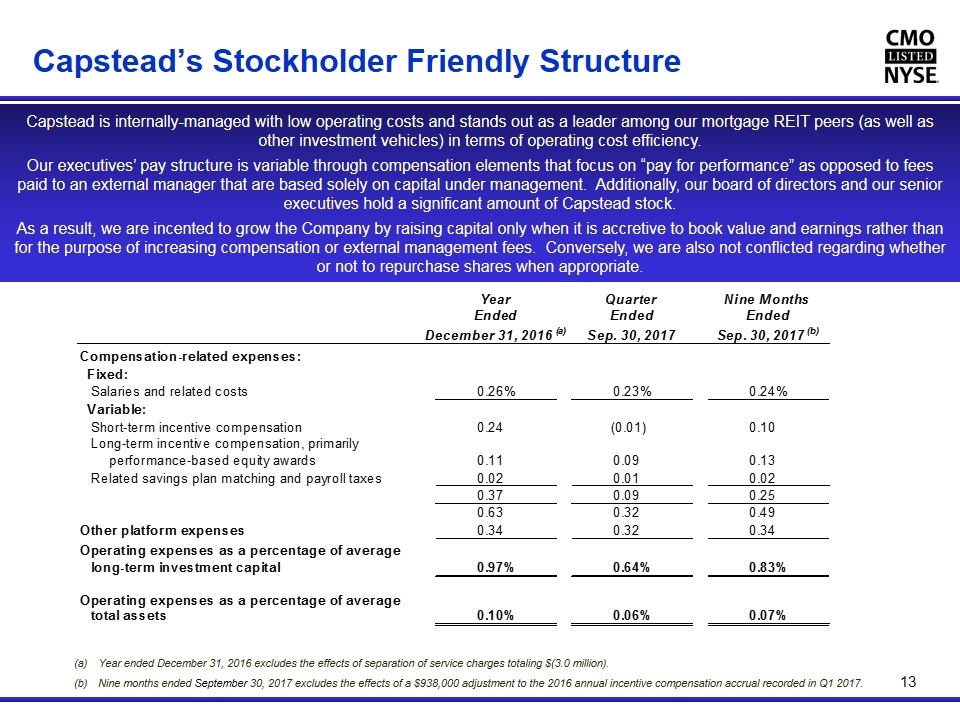
Capstead’s Stockholder Friendly Structure 13 Year ended December 31, 2016 excludes the effects of separation of service charges totaling $(3.0 million). Nine months ended September 30, 2017 excludes the effects of a $938,000 adjustment to the 2016 annual incentive compensation accrual recorded in Q1 2017. Capstead is internally-managed with low operating costs and stands out as a leader among our mortgage REIT peers (as well as other investment vehicles) in terms of operating cost efficiency. Our executives’ pay structure is variable through compensation elements that focus on “pay for performance” as opposed to fees paid to an external manager that are based solely on capital under management. Additionally, our board of directors and our senior executives hold a significant amount of Capstead stock. As a result, we are incented to grow the Company by raising capital only when it is accretive to book value and earnings rather than for the purpose of increasing compensation or external management fees. Conversely, we are also not conflicted regarding whether or not to repurchase shares when appropriate.
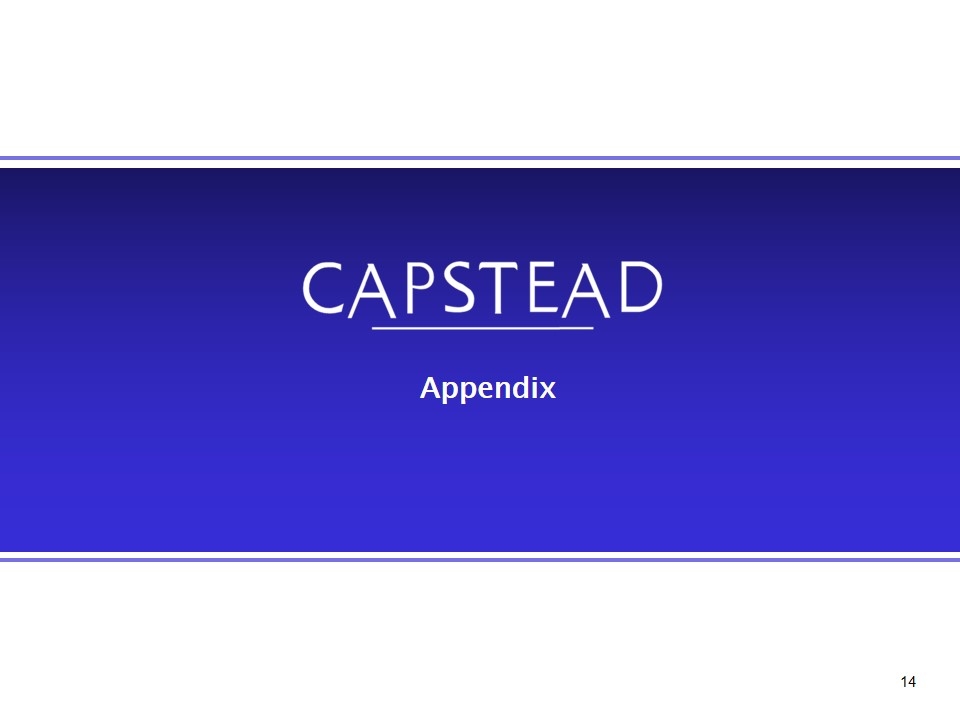
Appendix 14
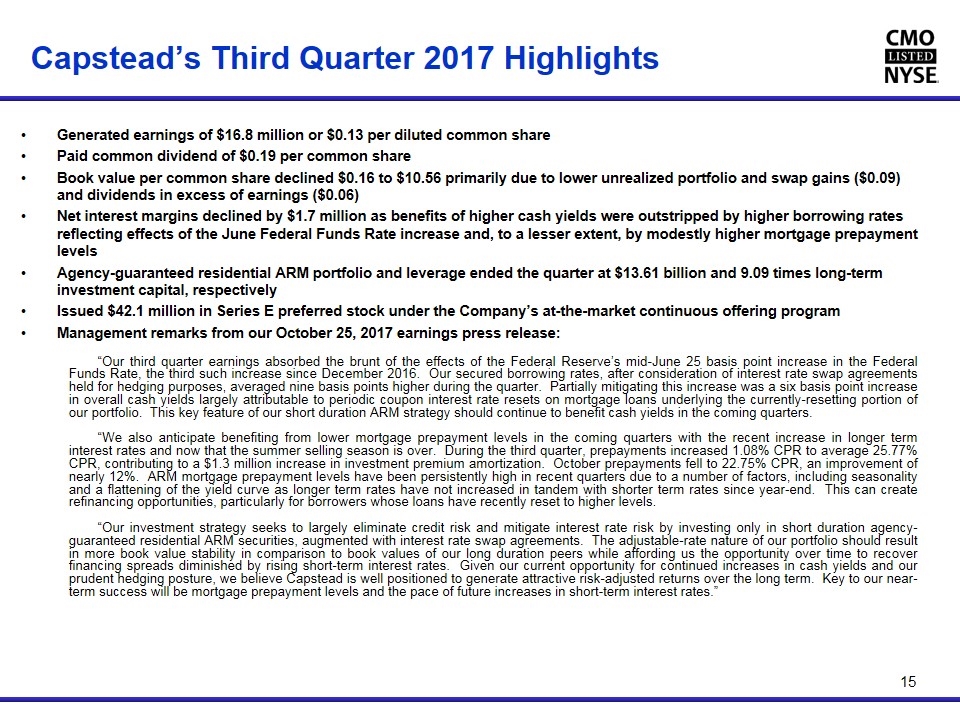
Capstead’s Third Quarter 2017 Highlights Generated earnings of $16.8 million or $0.13 per diluted common share Paid common dividend of $0.19 per common share Book value per common share declined $0.16 to $10.56 primarily due to lower unrealized portfolio and swap gains ($0.09) and dividends in excess of earnings ($0.06) Net interest margins declined by $1.7 million as benefits of higher cash yields were outstripped by higher borrowing rates reflecting effects of the June Federal Funds Rate increase and, to a lesser extent, by modestly higher mortgage prepayment levels Agency-guaranteed residential ARM portfolio and leverage ended the quarter at $13.61 billion and 9.09 times long-term investment capital, respectively Issued $42.1 million in Series E preferred stock under the Company’s at-the-market continuous offering program Management remarks from our October 25, 2017 earnings press release: “Our third quarter earnings absorbed the brunt of the effects of the Federal Reserve’s mid-June 25 basis point increase in the Federal Funds Rate, the third such increase since December 2016. Our secured borrowing rates, after consideration of interest rate swap agreements held for hedging purposes, averaged nine basis points higher during the quarter. Partially mitigating this increase was a six basis point increase in overall cash yields largely attributable to periodic coupon interest rate resets on mortgage loans underlying the currently-resetting portion of our portfolio. This key feature of our short duration ARM strategy should continue to benefit cash yields in the coming quarters. “We also anticipate benefiting from lower mortgage prepayment levels in the coming quarters with the recent increase in longer term interest rates and now that the summer selling season is over. During the third quarter, prepayments increased 1.08% CPR to average 25.77% CPR, contributing to a $1.3 million increase in investment premium amortization. October prepayments fell to 22.75% CPR, an improvement of nearly 12%. ARM mortgage prepayment levels have been persistently high in recent quarters due to a number of factors, including seasonality and a flattening of the yield curve as longer term rates have not increased in tandem with shorter term rates since year-end. This can create refinancing opportunities, particularly for borrowers whose loans have recently reset to higher levels. “Our investment strategy seeks to largely eliminate credit risk and mitigate interest rate risk by investing only in short duration agency-guaranteed residential ARM securities, augmented with interest rate swap agreements. The adjustable-rate nature of our portfolio should result in more book value stability in comparison to book values of our long duration peers while affording us the opportunity over time to recover financing spreads diminished by rising short-term interest rates. Given our current opportunity for continued increases in cash yields and our prudent hedging posture, we believe Capstead is well positioned to generate attractive risk-adjusted returns over the long term. Key to our near-term success will be mortgage prepayment levels and the pace of future increases in short-term interest rates.” 15
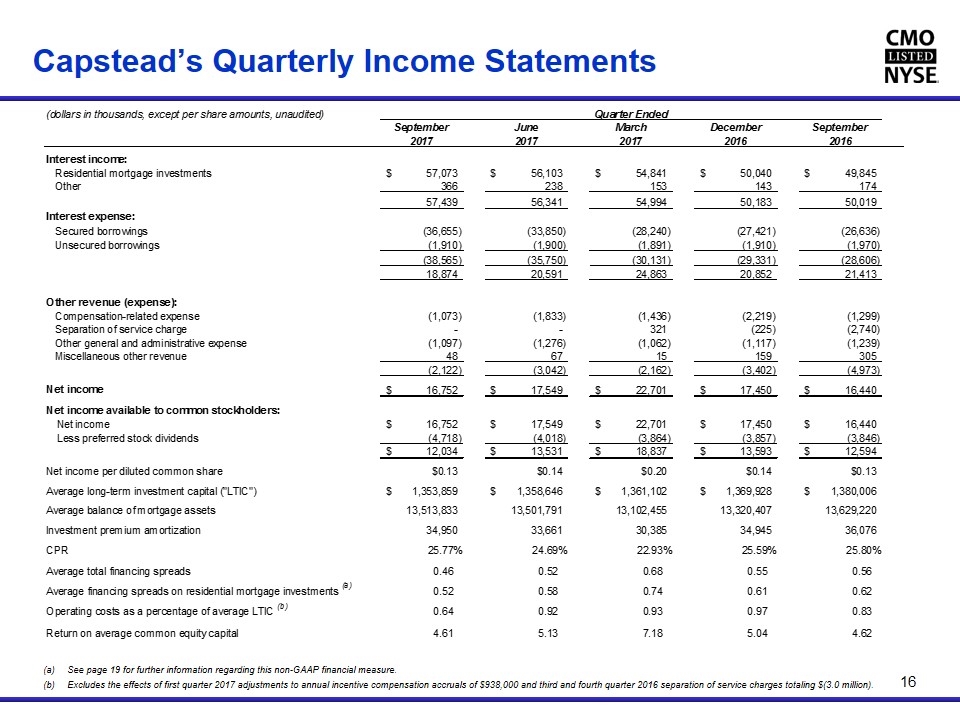
Capstead’s Quarterly Income Statements 16 See page 19 for further information regarding this non-GAAP financial measure. Excludes the effects of first quarter 2017 adjustments to annual incentive compensation accruals of $938,000 and third and fourth quarter 2016 separation of service charges totaling $(3.0 million).
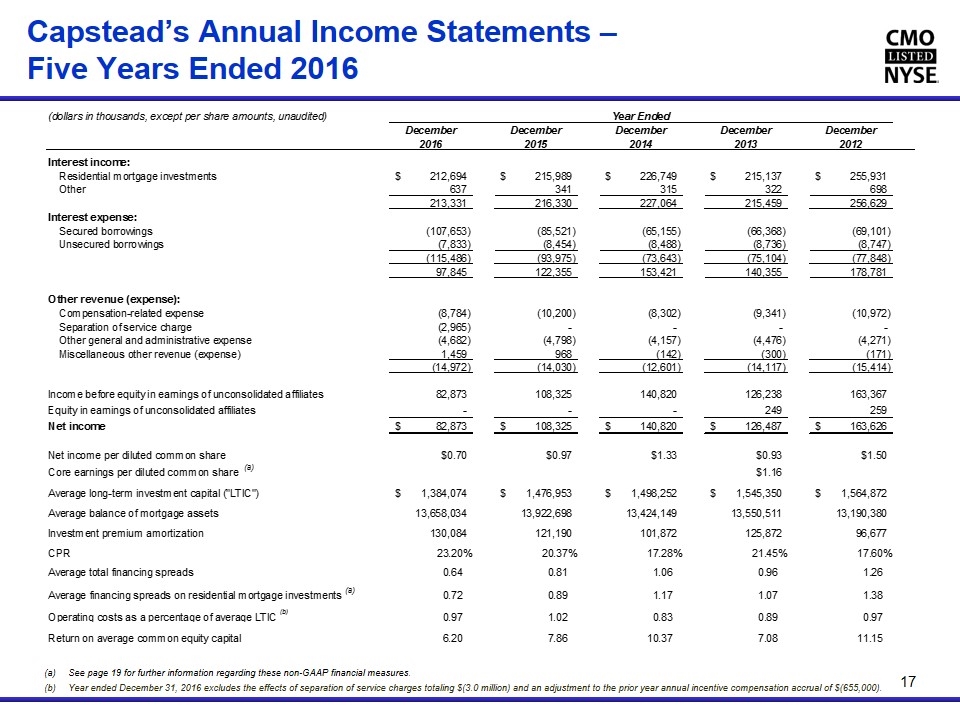
Capstead’s Annual Income Statements – Five Years Ended 2016 17 See page 19 for further information regarding these non-GAAP financial measures. Year ended December 31, 2016 excludes the effects of separation of service charges totaling $(3.0 million) and an adjustment to the prior year annual incentive compensation accrual of $(655,000).

Capstead’s Comparative Balance Sheets 18
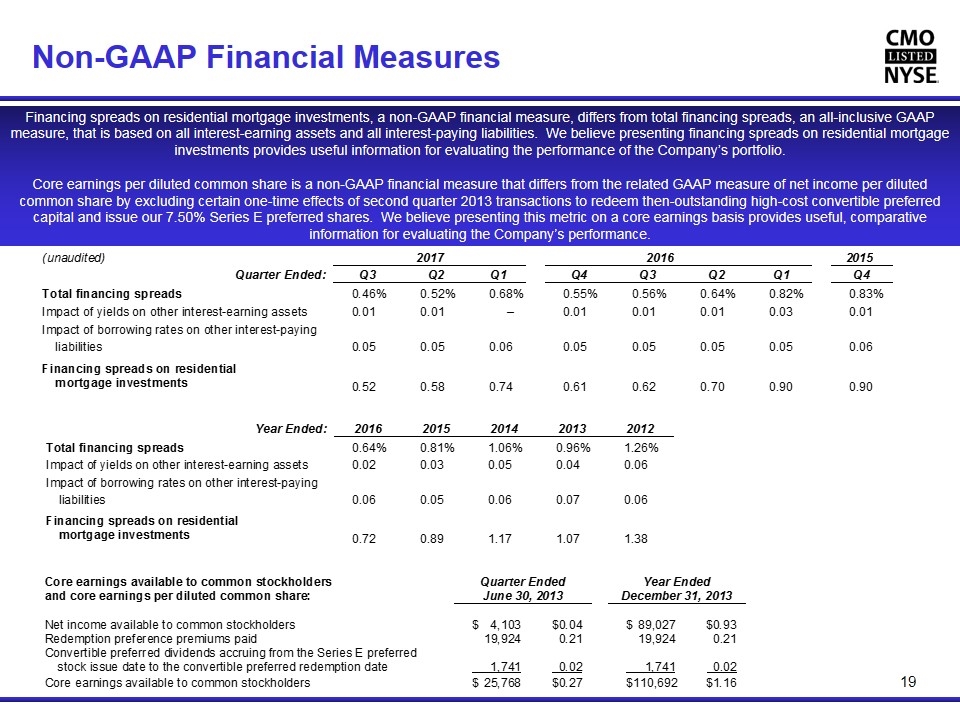
Non-GAAP Financial Measures 19 Financing spreads on residential mortgage investments, a non-GAAP financial measure, differs from total financing spreads, an all-inclusive GAAP measure, that is based on all interest-earning assets and all interest-paying liabilities. We believe presenting financing spreads on residential mortgage investments provides useful information for evaluating the performance of the Company’s portfolio. Core earnings per diluted common share is a non-GAAP financial measure that differs from the related GAAP measure of net income per diluted common share by excluding certain one-time effects of second quarter 2013 transactions to redeem then-outstanding high-cost convertible preferred capital and issue our 7.50% Series E preferred shares. We believe presenting this metric on a core earnings basis provides useful, comparative information for evaluating the Company’s performance. Core earnings available to common stockholders Quarter EndedYear Endedand core earnings per diluted common share:June 30, 2013December 31, 2013Net income available to common stockholders$4,103$0.04$89,027$0.93Redemption preference premiums paid19,9240.2119,9240.21Convertible preferred dividends accruing from the Series E preferredstock issue date to the convertible preferred redemption date1,7410.021,7410.02Core earnings available to common stockholders$25,768$0.27$110,692$1.16
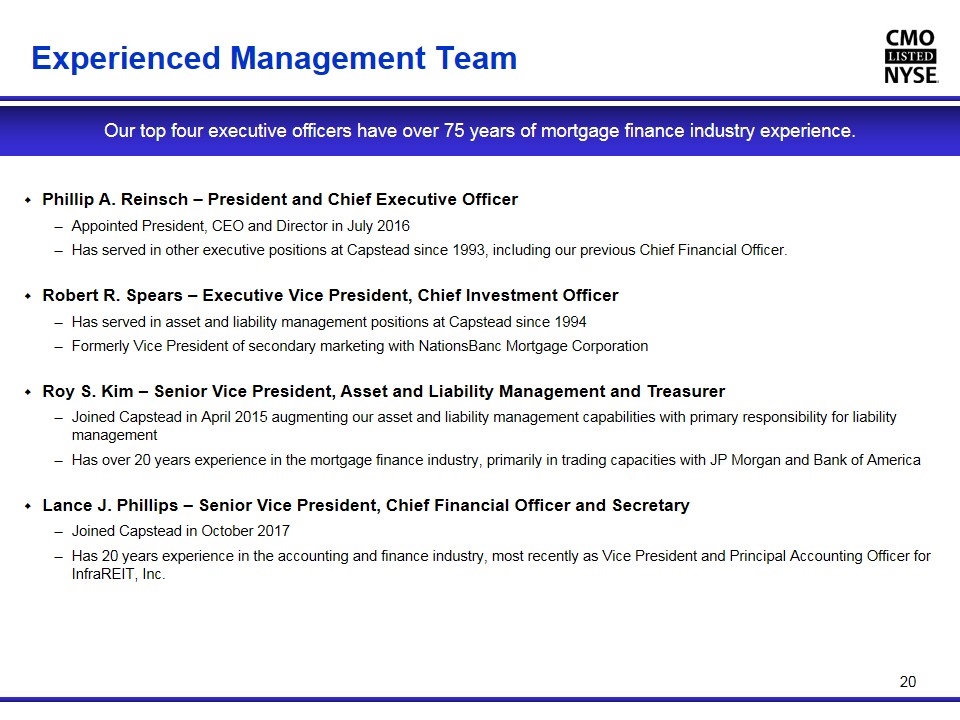
Experienced Management Team 20 Our top four executive officers have over 75 years of mortgage finance industry experience. Phillip A. Reinsch – President and Chief Executive Officer Appointed President, CEO and Director in July 2016 Has served in other executive positions at Capstead since 1993, including our previous Chief Financial Officer. Robert R. Spears – Executive Vice President, Chief Investment Officer Has served in asset and liability management positions at Capstead since 1994 Formerly Vice President of secondary marketing with NationsBanc Mortgage Corporation Roy S. Kim – Senior Vice President, Asset and Liability Management and Treasurer Joined Capstead in April 2015 augmenting our asset and liability management capabilities with primary responsibility for liability management Has over 20 years experience in the mortgage finance industry, primarily in trading capacities with JP Morgan and Bank of America Lance J. Phillips – Senior Vice President, Chief Financial Officer and Secretary Joined Capstead in October 2017 Has 20 years experience in the accounting and finance industry, most recently as Vice President and Principal Accounting Officer for InfraREIT, Inc.



















